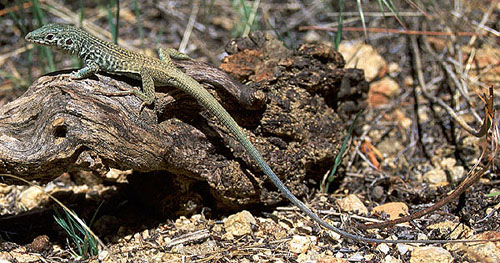Reptile and amphibian keepers are fortunate to have at our disposal a huge array of substrates, many of which are formulated for specific animals (burrowing frogs, large snakes). However, there are still a few situations, usually involving especially sensitive species, where we may need to improvise. Today I’d like to relate my experiences using “alternative” substrates for desert-dwelling reptiles and hatchling tortoises. I have long used both while working with animals in zoos, but have noticed that neither is well-known in the pet trade.
The Immune Systems of Desert Dwellers

Potential Problems with Sand
 Many of the substrates traditionally used for such creatures, including most types of sand, harbor molds and fungi when damp. Although not a problem (in limited-contact situations) for all desert animals, some are especially sensitive and quickly succumb to skin and respiratory infections.
Many of the substrates traditionally used for such creatures, including most types of sand, harbor molds and fungi when damp. Although not a problem (in limited-contact situations) for all desert animals, some are especially sensitive and quickly succumb to skin and respiratory infections.
Chief among these in my experience are Egyptian tortoises (Testudo kleimanni), padloper tortoises (Homopus signatus, the world’s smallest tortoise) and several of the whip-tailed lizards (Cnemidophorus spp.).
Using Oyster Shell
Oyster shell (available at garden and poultry supply stores) does not support the growth of fungi or mold, is benign when swallowed in small amounts, and can be easily spot-cleaned and discarded when fouled. I cannot recall any skin or respiratory problems in desert-dwelling reptiles maintained on oyster shell.
Further Reading
You can read more about fungal and other respiratory ailments in tortoises at: http://www.azeah.com/Care-Sheets.asp?id=125
Tortoise photo referenced from Wikipedia and originally posted by Stefano Alcini.
 That Reptile Blog – Reptile, Amphibian and Exotic Pet Care and Information
That Reptile Blog – Reptile, Amphibian and Exotic Pet Care and Information



Hello! I have a hatchling Egyptian, and I originally started out with oyster she’ll until I realized I was allergic to it.
What other type of substrate could I use for my tortoise, aside from rabbit pellets?
Hello,
You can keep them on a mix of dry top soil and sand; feed from a bowl and place the bowl on newspapers to prevent substrate ingestion. I’ve not run across references to allergies…you may wish to check that symptoms are not related to another health problem (respiratory infection, etc). Best, Frank